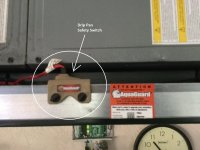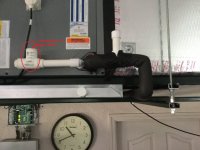Giantsean
Member
Hey All,
Those who may remember my post about my HVAC installers being hacks... we now have another hacktastic milestone in their road to hack nirvana. They just can't stop topping themselves.
So long story short we have an attic mounted Trane/AS hydro air handler which services the 2nd floor. It sits in a sheet metal catch pan bent and sealed by the Hack Bros. Tonight my daughter alerts me that the paint on the wall outside her room is bubbling. Uh oh.
So I go up the attic stairs to find the pan full, the drain pipe filled to level of the cleanout, and a whole bay full of sopping fiberglass. Fortunately the hacks installed an overflow cutoff to prevent this very situation. UNfortunately they apparently don't know how to seal the corners of the pan when they build them, because it was happily dripping it's contents out of the lowest corner (which of course was the least accessible one... of course).
I shut everything down, dried what I could, and tried forcing the water down the drain in a variety of ways (none really good) and eventually it seems to have worked as it returned to the trap weir level and stayed there.
Luckily the damage was not TOO bad. I will have to fix and repaint a good sized area but the drywall still feels hard, so I it could have been much worse. Still, why wouldn't the float trigger? Unless it was a vicious cycle of on/off due to the dripping pan? What causes drains to clog in the first place? We are still doing a lot of construction upstairs (wood and drywall dust) though I am changing the filter regularly and shutting off the system when we do anything super dusty. Could dust be washing off the coil and jamming up in there? Finally, the pan is not actually UNDER the drain cleanout and there was no water directly under it. If it backed up, where would it actually leak from? the air handler itself?
Thanks for letting me vent, and for any info!
Those who may remember my post about my HVAC installers being hacks... we now have another hacktastic milestone in their road to hack nirvana. They just can't stop topping themselves.
So long story short we have an attic mounted Trane/AS hydro air handler which services the 2nd floor. It sits in a sheet metal catch pan bent and sealed by the Hack Bros. Tonight my daughter alerts me that the paint on the wall outside her room is bubbling. Uh oh.
So I go up the attic stairs to find the pan full, the drain pipe filled to level of the cleanout, and a whole bay full of sopping fiberglass. Fortunately the hacks installed an overflow cutoff to prevent this very situation. UNfortunately they apparently don't know how to seal the corners of the pan when they build them, because it was happily dripping it's contents out of the lowest corner (which of course was the least accessible one... of course).
I shut everything down, dried what I could, and tried forcing the water down the drain in a variety of ways (none really good) and eventually it seems to have worked as it returned to the trap weir level and stayed there.
Luckily the damage was not TOO bad. I will have to fix and repaint a good sized area but the drywall still feels hard, so I it could have been much worse. Still, why wouldn't the float trigger? Unless it was a vicious cycle of on/off due to the dripping pan? What causes drains to clog in the first place? We are still doing a lot of construction upstairs (wood and drywall dust) though I am changing the filter regularly and shutting off the system when we do anything super dusty. Could dust be washing off the coil and jamming up in there? Finally, the pan is not actually UNDER the drain cleanout and there was no water directly under it. If it backed up, where would it actually leak from? the air handler itself?
Thanks for letting me vent, and for any info!



